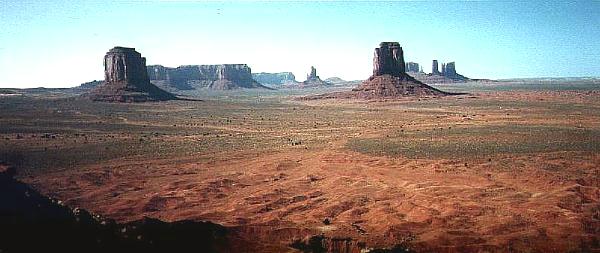Nonetheless, statistical tests have been developed to
determine distributions. Three alternatives are
recognized:
- Spp. distributional limits are regularly spaced
- Spp. distributional limits are randomly arranged
- Spp. distributional limits are clustered along the
gradient, producing apparent communities
- Again, departures from random patterns do not tell us
anything about competition (or any other process)
- Spp. may have similar distributional limits
because of similar physiological tolerance limits
- Clusters of distributional limits may be
attributed to the way the observer divided the
gradient
- Herbivores may stop at a certain point along the
gradient, and therefore create discontinuities
- One or more competitive dominants may set the
distributional limits of an entire group of spp.
- Only the last hypothesis is consistent w/ competition,
and hypotheses 1-3 are very difficult to reject
More
graphics
COMPARATIVE STUDIES
Follow directly from descriptive studies, in that observational
data are used to describe patterns, and resulting patterns are
compared to infer differences in process
Value in comparative studies lies in the spatial and temporal
scales which they can consider
- Caution:
- Since there is not an experiment, researcher is always
forced to compare patterns and then invoke mechanisms
Comparative studies are commonly used to infer presence or
strength of interactions when experimental studies are difficult
to conduct
As w/ descriptive studies, it is tempting to collect data w/o
first asking a question
EXPERIMENTAL STUDIES
An experiment requires you to specify a question and a means of
answering the question in advance, so experimental studies tend
to be better-designed than descriptive or comparative studies
- e.g., a common hypothesis proposed for many studies of competition is
that competition is structuring a community in a certain manner
- a manipulation is then performed to test this hypothesis
- dependent and independent variables must be specified
- dependent: characteristic that measure the performance
of indivs. or pop'ns
- independent: abundance of neighbors; a negative
relationship is predicted between abundance of
neighbors and performance measures
- Laboratory experiments
- tell what could potentially happen in nature under specific
sets of conditions which can not be produced in the field
- advantage: researcher can manipulate a wide range of biotic
and abiotic variables
- disadvantage: limited scope, extreme unrealism; however
convincingly phenomena are demonstrated in lab, can not
extrapolate from controlled environment to the actual
existence of a process in nature
- Field experiments
- unlike lab studies, there is a reference point: current
performance of indivs. or pop'ns of interest [Fig. 4.6
Keddy 1989 p. 94]
- Descriptive and comparative studies do not test for an ecological
process--they test for a pattern and infer a mechanism
- Experiments do not necessarily overcome this problem--they may
eliminate the largest number of alternative hypotheses, but manipulations
of, for example, 'interference', really test for density dependence
- 'Apparent' competition (resulting from indirect
effects) has been proposed to explain density
dependence; examples:
- the removed species may have been a host for a
pathogen which also damaged the remaining species
- the removed species may have attracted a herbivore
which also fed upon the remaining species
- Parker and Root (1981 Ecology 62:1390-1392) showed
that a herbaceous plant species was excluded by
some habitats by a grasshopper assoc. w/ a common
shrub; removal of the shrub --> incr. in herb, but
w/o interaction between the 2 spp.
- these examples indicate:
- mechanisms of ecological interactions may be very complex
- natural history can not be divorced from experiments
The most important part of ecological research is the choice of
the question
Because ecologists usually enjoy field work, it is tempting to rush
into data collection w/o first taking the time to think
An appropriate strategy for conducting ecological research is
presented by Keddy [Table 4.4 p. 97]
In the absence of generality, ecology is nothing more than
natural history. How can we increase the generality of field
experiments? Keddy (1989) proposes:
- Demonstrate that the pattern is a general one
- Use increased no. of spp.
- tradeoff may be whether to pose complex questions w/ a few
spp. or simple ones w/ a lot of spp.
- Provide a comparative context
- select spp. because they are representative (in some way) of
a large group of spp. of interest
- groups can be defined after the experiment is conducted, too
(e.g., gap-colonizers vs. shade-tolerant spp.)
- then, present results not based on species responses, but on
responses of groups [Table 5.2 Keddy 1989 p. 108]
- Use general experimental factors
- Arrange experiments along gradients
- incorporates variation --> expanded generality
- variation is incorporated systematically, so you can
tell how trt effects vary along the gradient
- e.g., Gurevitch (1986)
Previous
lectureNext
lecture
